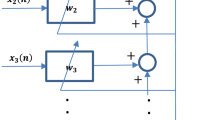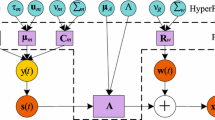Abstract
The paper discusses the effectiveness of the method for determining the parameters of the useful signal in the sliding window mode, provided that it is possible to obtain preliminary estimates for the noise distribution. For the statistical experiment, \(24\) samples had been generated with different ratios between the signal and noise parameters. Implementation of the computational procedures for the adaptive method in the Python programming language is proposed. For the test samples, it is demonstrated that the magnitude of the error in evaluating the parameters in the vast majority of cases does not exceed value 1 (in terms of the standard RMSE metrics). In addition, an effective two-pass method for detecting the moment of the appearance of a meaningful signal in the noisy data is proposed. The results of its operation are also demonstrated on the example of the mentioned test samples.
Keywords:
finite normal mixtures, method of moving separation of mixtures, detection, signal, noise, EM algorithm, computational algorithm




Similar content being viewed by others
REFERENCES
S. Márquez-Figueroa, Y. S. Shmaliy, and O. Ibarra-Manzano, “Optimal extraction of EMG signal envelope and artifacts removal assuming colored measurement noise,” Biomed. Signal Process. Control 57, Article 101679 (2020).
H. Almgren, F. Van de Steen, A. Razi, K. Friston, and D. Marinazzo, “The effect of global signal regression on DCM estimates of noise and effective connectivity from resting state fMRI,” NeuroImage 208, Article 116435 (2020).
H. Asadi and B. Seyfe, “Signal enumeration in Gaussian and non-Gaussian noise using entropy estimation of eigenvalues,” Digital Signal Process. 78, 163–174 (2018).
M. C. Ilter, H. U. Sokun, H. Yanikomeroglu, R. Wichman, and J. Hämäläinen, “The joint impact of fading severity, irregular constellation, and non-Gaussian noise on signal space diversity-based relaying networks,” IEEE Access 7, 116162–116171 (2019).
J. Guo, H. Zhang, D. Zhen, Z. Shi, F. Gu, and A. D. Ball, “An enhanced modulation signal bispectrum analysis for bearing fault detection based on non-Gaussian noise suppression,” Meas. 151, Article 107240 (2020).
Y. Li, Z. Li, K. Wei, W. Xiong, J. Yu, and B. Qi, “Noise estimation for image sensor based on local entropy and median absolute deviation,” Sensors 19 (2), Article 339 (2019).
A. K. Gorshenin, “Data noising by finite normal and gamma mixtures with application to the problem of rounded observations,” Inform. Primen. (Inf. Appl.) 12 (3), 28–34 (2018) [in Russian].
A. K. Gorshenin, “Adaptive detection of normal mixture signals with pre-estimated Gaussian mixture noise,” Pattern Recogn. Image Anal. 29 (3), 377–383 (2019).
V. Yu. Korolev, Probabilistic and Statistical Methods of Decomposition of Volatility of Chaotic Processes (Mosk. Gos. Univ., Moscow, 2011) [in Russian].
E. S. Page, “On problems in which a change in a parameter occurs at an unknown point,” Biometrika 44 (1–2), 248–252 (1957).
D. Picard, “Testing and estimating change-points in time series,” Adv. Appl. Prob. 17 (4), 841–867 (1985).
J. Bloemer, S. Brauer, K. Bujna, and D. Kuntze, “How well do SEM algorithms imitate EM algorithms? A non-asymptotic analysis for mixture models,” Adv. Data Anal. Classif. 14 (1), 147–173 (2020).
Y. Tang, “Beyond EM: A faster Bayesian linear regression algorithm without matrix inversions,” Neurocomput. 378, 435–440 (2020).
Y. Tuac, Y. Guney, and O. Arslan, “Parameter estimation of regression model with AR(p) error terms based on skew distributions with EM algorithm,” Soft Comput. 24 (5), 3309–3330 (2020).
C. Liu, H.-C. Li, K. Fu, F. Zhang, M. Datcu, and W. J. Emery, “Bayesian estimation of generalized Gamma mixture model based on variational EM algorithm,” Pattern Recogn. 87, 269–284 (2019).
L. Yu, T. Yang, and A. B. Chan, “Density-preserving hierarchical EM algorithm: Simplifying Gaussian mixture models for approximate inference,” IEEE Trans. Pattern Anal. Mach. Intell. 41 (6), 1323–1337 (2019).
D. Wu and J. Ma, “An effective EM algorithm for mixtures of Gaussian processes via the MCMC sampling and approximation,” Neurocomput. 331, 366–374 (2019).
Y. Kojima, H. Matsumoto, and H. Kiryu, “Estimation of population genetic parameters using an EM algorithm and sequence data from experimental evolution populations,” Bioinf. 36 (1), 221–231 (2020).
A. K. Gorshenin, V. Yu. Korolev, and A. M. Tursunbayev, “Median modifications of the EM-algorithm for separation of mixtures of probability distributions and their applications to the decomposition of volatility of financial indexes,” J. Math. Sci. 227 (2), 176–195 (2018).
A. Gorshenin, V. Korolev, V. Kuzmin, and A. Zeifman, “Coordinate-wise versions of the grid method for the analysis of intensities of non-stationary information flows by moving separation of mixtures of gamma-distribution,” in Proc. 27th European Conference on Modelling and Simulation (ECMS 2013) (Ålesund, Norway, 2013), pp. 565–568.
A. K. Gorshenin, “On implementation of EM-type algorithms in the stochastic models for a matrix computing on GPU,” AIP Conf. Proc. 1648, Article 250008 (2015).
G. M. Batanov, V. D. Borzosekov, A. K. Gorshenin, N. K. Kharchev, V. Yu. Korolev, and K. A. Sarskyan. “Evolution of statistical properties of microturbulence during transient process under electron cyclotron resonance heating of the L-2M stellarator plasma,” Plasma Phys. Controlled Fusion 61 (7), Article 075006 (2019).
ACKNOWLEDGMENTS
The authors are grateful to Prof. V.Yu. Korolev for useful discussions and valuable comments.
Funding
The research was conducted in accordance with the program of Moscow Center for Fundamental and Applied Mathematics. Andrey Gorshenin is also supported by the Russian Presidential scholarship program (no. 538.2018.5)
Author information
Authors and Affiliations
Corresponding authors
Ethics declarations
The authors declare that they have no conflict of interest.
Additional information

Andrey K. Gorshenin. Born 1986. Received candidate’s degree in science of physics–mathematics (probability theory and mathematical statistics) from Moscow State University in 2011, appointed associate professor (mathematical modeling, numerical methods, and software systems) in 2017, leading researcher at Federal Research Center “Computer Science and Control” of the Russian Academy of Sciences, leading researcher at the Faculty of Computational Mathematics and Cybernetics, Moscow State University, and leading researcher at Moscow Center for Fundamental and Applied Mathematics (world-class mathematical center in Russia). Received specialist degree with honors in applied mathematics and computer science from the Faculty of Computational Mathematics and Cybernetics, Moscow State University, in 2008. Member of the Skolkovo Expert Panel, Moscow, Russia; academic expert of the National Research University Higher School of Economics, Moscow, Russia; expert at the Russian Foundation for Basic Research, Moscow, Russia; expert of the Russian Academy of Sciences, Moscow, Russia; and external expert of the Foundation for Assistance to Small Innovative Enterprises, Moscow, Russia. Member of the editorial boards of the peer-reviewed journals “Informatika i ee primeneniya” (Scopus) and “Systems and Means of Informatics.” Member of the Coordination Committee for Youth Affairs in Science and Education (Presidential Council of the Russian Federation for Science and Education). Awards: President’s Grant for Government Support of Young Russian Scientists in 2014–2015, Russian Academy of Sciences Medal, Prize for Young Scientists in 2015, and Scholarship of the President of the Russian Federation for Young Scientists and Postgraduates in 2018–2020. Grant supervisor, Russian Science Foundation, Russian Foundation for Basic Research, President’s Grant for Government Support of Young Russian Scientists. Reviewer in the journal “Applied Soft Computing” (Q1 Web of Science and Scopus). His scientific interests are probability theory, mathematical statistics, computer sciences, modeling of real processes, EM algorithms, method of moving separation of mixture distributions, mathematical modeling, machine learning, neural networks, big data, and data visualization. Author of 157 papers and textbooks, as well as 72 certificates of state registration of software issued by the Russian Federal Service for Intellectual Property.

Anastasia A. Shcherbinina. Born 1997. Studying for the Master’s degree at the Faculty of Computational Mathematics and Cybernetics, Moscow State University. Received bachelor’s degree in applied mathematics and computer science from the Faculty of Computational Mathematics and Cybernetics, Moscow State University in 2019. Her scientific interests are: probability theory, mathematical statistics, EM algorithm, and machine learning.
Rights and permissions
About this article
Cite this article
Gorshenin, A.K., Shcherbinina, A.A. Efficiency of the Method for Detecting Normal Mixture Signals with Pre-Estimated Gaussian Mixture Noise. Pattern Recognit. Image Anal. 30, 470–479 (2020). https://doi.org/10.1134/S1054661820030074
Received:
Revised:
Accepted:
Published:
Issue Date:
DOI: https://doi.org/10.1134/S1054661820030074




